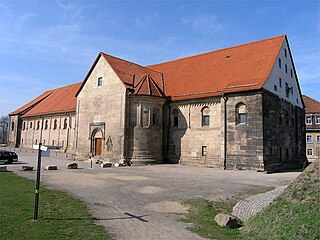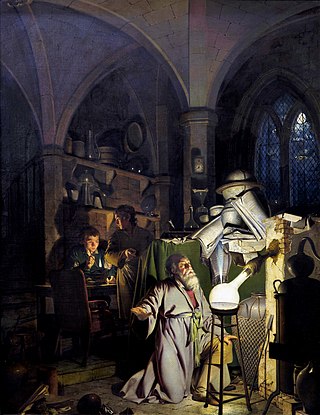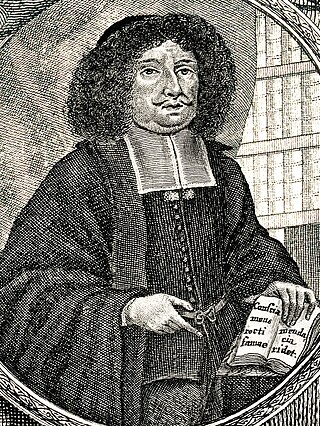

Musaeum Hermeticum ("Hermetic library") is a compendium of alchemical texts first published in German, in Frankfurt, 1625 by Lucas Jennis. [1] Additional material was added for the 1678 Latin edition, which in turn was reprinted in 1749.


Musaeum Hermeticum ("Hermetic library") is a compendium of alchemical texts first published in German, in Frankfurt, 1625 by Lucas Jennis. [1] Additional material was added for the 1678 Latin edition, which in turn was reprinted in 1749.
Its purpose was apparently to supply in a compact form a representative collection of relatively brief and less ancient alchemical writings; it could be regarded as a supplement to those large storehouses of Hermetic learning such as the Theatrum Chemicum , or Jean-Jacques Manget's Bibliotheca Chemica Curiosa . It seemed to represent a distinctive school in Alchemy, less committed to the past and less obscure than the works of older and more traditional alchemical masters. [2]
The full Latin title is: "Musæum Hermeticum, omnes sopho-spagyricæ artis discipulos fidelissime erudiens, quo pacto summa illa veraque Medicina, qua res omne, qualemcumque defectum patientes, instaurari possunt (quæ alias Benedictus Lapis Sapientum appellatur) inveniri ac haberi queat inveniri ac haberi queat. Continens tractatus chymicos novem præatantissimos, quorum nomina et seriem versa pagella indicabit. In gratiam filiorum doctrinæ, quibus Germanicum Idioma ignotum, in Latinum conversum ac juris publici factum. Jennis"
The first edition contained:
The illustrated book contains 445 + 35 pages.

The 1678 edition is 863 pages long, and includes: [3]

Roger Bacon, also known by the scholastic accolade Doctor Mirabilis, was a medieval English philosopher and Franciscan friar who placed considerable emphasis on the study of nature through empiricism. In the early modern era, he was regarded as a wizard and particularly famed for the story of his mechanical or necromantic brazen head. He is sometimes credited as one of the earliest European advocates of the modern scientific method, along with his teacher Robert Grosseteste. Bacon applied the empirical method of Ibn al-Haytham (Alhazen) to observations in texts attributed to Aristotle. Bacon discovered the importance of empirical testing when the results he obtained were different from those that would have been predicted by Aristotle.

Rosicrucianism is a spiritual and cultural movement that arose in early modern Europe in the early 17th century after the publication of several texts announcing to the world a new esoteric order. Rosicrucianism is symbolized by the Rosy Cross or Rose Cross. There have been several Rosicrucian organizations, since the initial movement was founded, including the Order of the Golden and Rosy Cross (1750s–1790s), the Societas Rosicruciana in Anglia (1865–present), and the Hermetic Order of the Golden Dawn (1887–1903).

Arthur Edward Waite was a British poet and scholarly mystic who wrote extensively on occult and esoteric matters, and was the co-creator of the Rider–Waite tarot deck. As his biographer R. A. Gilbert described him, "Waite's name has survived because he was the first to attempt a systematic study of the history of Western occultism—viewed as a spiritual tradition rather than as aspects of protoscience or as the pathology of religion."

Basil Valentine is the Anglicised version of the name Basilius Valentinus, ostensibly a 15th-century alchemist, possibly Canon of the Benedictine Priory of Saint Peter in Erfurt, Germany but more likely a pseudonym used by one or several 16th-century German authors.

The philosopher's stone is a mythic alchemical substance capable of turning base metals such as mercury into gold or silver. It is also called the elixir of life, useful for rejuvenation and for achieving immortality; for many centuries, it was the most sought-after goal in alchemy. The philosopher's stone was the central symbol of the mystical terminology of alchemy, symbolizing perfection at its finest, divine illumination, and heavenly bliss. Efforts to discover the philosopher's stone were known as the Magnum Opus.

Robert Fludd, also known as Robertus de Fluctibus, was a prominent English Paracelsian physician with both scientific and occult interests. He is remembered as an astrologer, mathematician, cosmologist, Qabalist and Rosicrucian.

Hermeticism or Hermetism is a philosophical and religious system based on the purported teachings of Hermes Trismegistus. These teachings are contained in the various writings attributed to Hermes, which were produced over a period spanning many centuries and may be very different in content and scope.

Johann Joachim Becher was a German physician, alchemist, precursor of chemistry, scholar, polymath and adventurer, best known for his development of the phlogiston theory of combustion, and his advancement of Austrian cameralism.

The so-called Emerald Tablet or Tabula Smaragdina is a one paragraph long Hermetic text. It was a highly regarded foundational text for many Islamic and European alchemists. Though attributed to the legendary Hellenistic figure Hermes Trismegistus, the text of the Emerald Tablet first appears in a number of early medieval Arabic sources, the oldest of which dates to the late eighth or early ninth century. It was translated into Latin several times in the twelfth and thirteenth centuries. Numerous interpretations and commentaries followed.

Michael Maier was a German physician and counsellor to Rudolf II Habsburg. He was a learned alchemist, epigramist, and amateur composer.
Nicolas Barnaud (1538–1604) was a French Protestant writer, physician and alchemist, from Crest, in Dauphiné, from which he took the name Delphinas. He was a member of the Monarchomaques.

Monas Hieroglyphica is a book by John Dee, the Elizabethan magus and court astrologer of Elizabeth I of England, published in Antwerp in 1564. It is an exposition of the meaning of an esoteric symbol that he invented.
The salamander is an amphibian of the order Urodela which, as with many real creatures, often has been ascribed fantastic and sometimes occult qualities by pre-modern authors not possessed by the real organism. The legendary salamander is often depicted as a typical salamander in shape with a lizard-like form, but is usually ascribed an affinity with fire, sometimes specifically elemental fire.

Theatrum Chemicum is a compendium of early alchemical writings published in six volumes over the course of six decades. The first three volumes were published in 1602, while the final sixth volume was published in its entirety in 1661. Theatrum Chemicum remains the most comprehensive collective work on the subject of alchemy ever published in the Western world.
Edward Cradock was an English theologian and alchemist.
Johannes Nicolaus Furichius (1602–1633) was a Franco-German Neo-Latin Imperial poet laureate, pharmacist, doctor of medicine and alchemist from Strasbourg.

Guglielmo Gratarolo or Grataroli or Guilelmus Gratarolus was an Italian doctor and alchemist.

Tripus Aureus or The Golden Tripod is an alchemical book by Michael Maier published in 1618 by Lucas Jennis. It contains three alchemical texts: The "twelve keys" of Basil Valentine, Thomas Norton's Ordinal of Alchemy (1477), and The Testament of Cremer.

The Twelve Keys of Basil Valentine is a widely reproduced alchemical book attributed to Basil Valentine. It was first published in 1599 by Johann Thölde who is likely the book's true author. It is presented as a sequence of alchemical operations encoded allegorically in words, to which images have been added. The first Basil Valentine book to discuss the keys is Ein kurtz summarischer Tractat, von dem grossen Stein der Uralten, 1599.

Baron Emmanuel van der Linden d'Hooghvorst (1914–1999) was a Belgian writer, spagyric philosopher and alchemist.